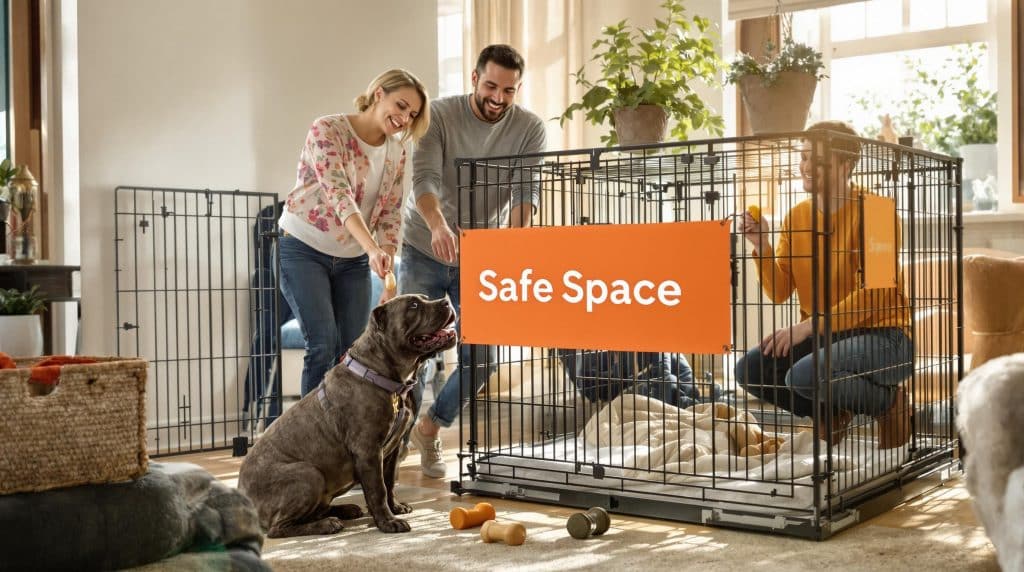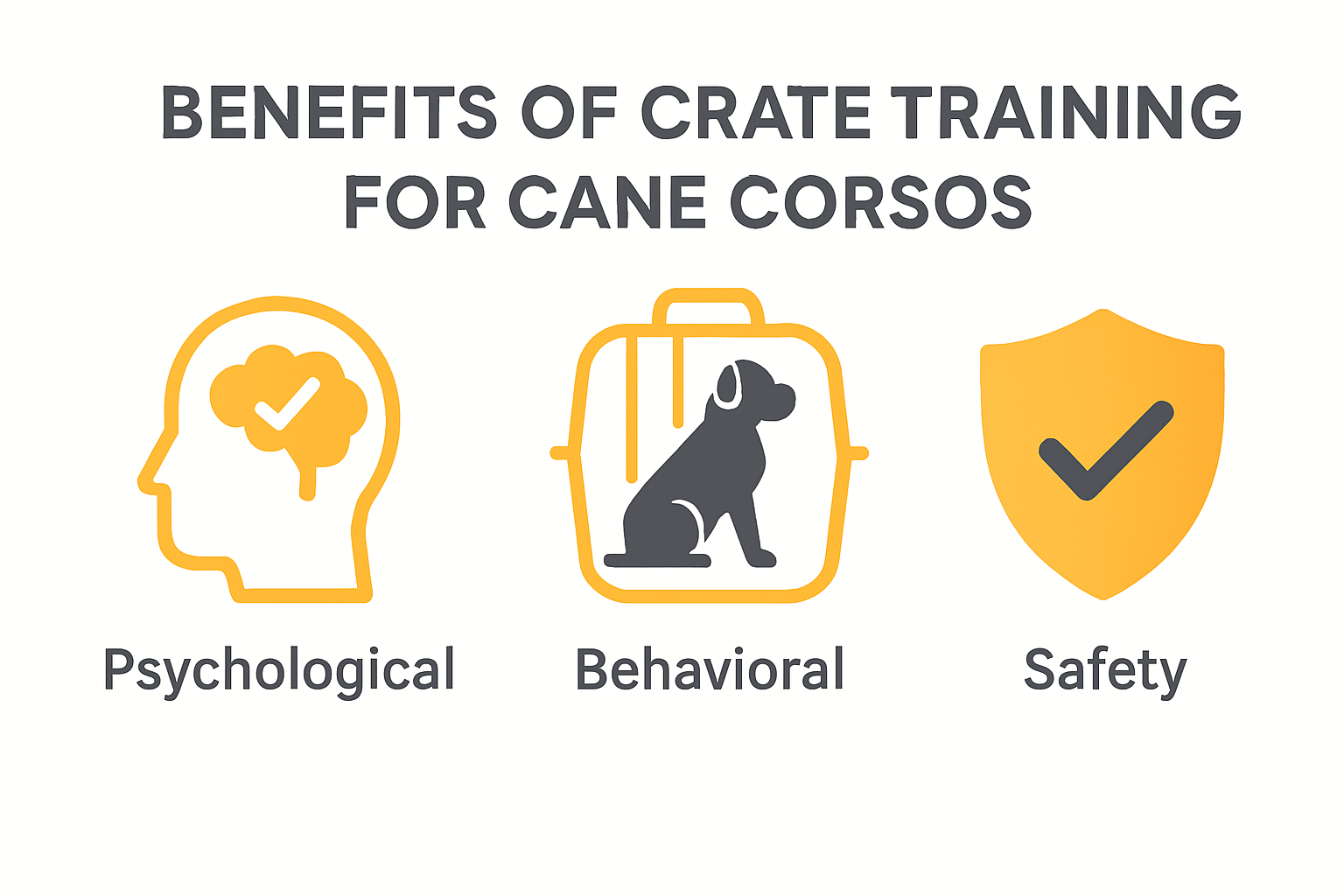Cane Corso crate training is more than a routine for dog owners. These powerful dogs can weigh up to 120 pounds full grown and need more structure and support than most breeds. Most people worry about crates being restrictive or stressful for pets, but the real surprise is that Cane Corsos actually thrive when given a proper crate routine. What matters most is that the crate quickly becomes their favorite safe place if you set it up the right way.
Table of Contents
- Why Crate Training Benefits Cane Corsos
- Step-By-Step Cane Corso Crate Training Guide
- Solving Common Crate Training Challenges
- Crate Training Tips For Families And Trainers
Quick Summary
| Takeaway | Explanation |
|---|---|
| Crate training is essential for Cane Corsos | It offers a safe space that can help reduce anxiety and promote security for this intelligent breed. |
| Select the right size crate | A well-fitting crate allows your Cane Corso to stand, turn, and lie down comfortably, aiding in effective training. |
| Create positive associations with the crate | Use treats and toys to make the crate inviting, ensuring your dog views it as a safe haven rather than punishment. |
| Be patient and gradual in training | Start with short crate durations, gradually increasing time for a stress-free introduction and to build your dog’s comfort. |
| Involve the whole family in training | Consistent communication and rules across family members enhance training success and respect for the Cane Corso’s space. |
Why Crate Training Benefits Cane Corsos
Crate training is a powerful tool that transforms the relationship between Cane Corso owners and their powerful canine companions. Far more than a simple containment method, crate training provides a structured approach to development, safety, and behavioral management for this intelligent and strong-willed breed.
A Safe Haven for Your Cane Corso
For Cane Corsos, a crate represents more than just a confined space – it becomes a personal sanctuary that taps into their natural den instincts. Veterinary experts from Texas A&M University highlight that crate training provides dogs with a secure environment where they can retreat, rest, and feel protected. This is particularly crucial for Cane Corsos, a breed known for their protective nature and need for personal space.
The psychological benefits are significant. When introduced correctly, the crate becomes a calm zone where your Cane Corso can decompress, reducing anxiety and providing a sense of security. This is especially important for a breed that can be sensitive to environmental changes and potentially overwhelming stimuli.
Behavioral Management and Training
According to veterinary research from UC Davis, crate training is an exceptional method for managing a young Cane Corso’s behavior. By limiting access to the entire house during critical learning periods, you can significantly reduce destructive behaviors and potential property damage. Cane Corsos are intelligent and strong dogs that require consistent guidance, and a crate provides a controlled environment for teaching boundaries and appropriate conduct.
The crate serves multiple training purposes. It assists in house training by leveraging the dog’s natural instinct to keep their sleeping area clean. Most dogs, including Cane Corsos, are reluctant to eliminate in their personal space, which makes the crate an effective tool for establishing bathroom routines and preventing indoor accidents.
Safety and Practical Benefits
Beyond behavioral training, crates offer practical safety advantages for Cane Corso owners. During travel, veterinary visits, or home renovations, a well-trained dog comfortable in their crate experiences less stress. The crate becomes a portable safe zone that provides consistency and comfort in potentially challenging environments.
For Cane Corsos, who can be large and powerful, having a reliable crate training foundation means easier management in various situations. Whether you need to temporarily restrict movement during home repairs, provide a secure space during social gatherings, or ensure safe transportation, a crate-trained Cane Corso offers peace of mind.
By investing time in proper crate training techniques, you’re not just teaching a skill – you’re building a foundation of trust, understanding, and mutual respect with your Cane Corso. The process requires patience, consistency, and a positive approach, but the rewards are substantial: a well-adjusted, confident dog who views their crate as a positive, safe space.
Step-by-Step Cane Corso Crate Training Guide
Successful crate training requires a strategic and patient approach, especially for a powerful and intelligent breed like the Cane Corso. This comprehensive guide will walk you through the essential steps to create a positive crate training experience that builds trust and comfort for your dog.
Selecting the Perfect Crate
Choosing the right crate is fundamental to successful training. According to the San Diego Humane Society, the crate should be large enough for your Cane Corso to stand up, turn around, and lie down comfortably. For this breed, which can grow quite large, measure your dog and select a crate that provides ample space without being excessively oversized.
Consider a crate with adjustable dividers if you’re training a puppy. This allows you to modify the crate’s size as your Cane Corso grows, ensuring it remains a perfect fit throughout different life stages. Look for sturdy construction that can withstand the strength of this powerful breed.
Here’s a table comparing key features to look for in a crate for a Cane Corso at different ages. This can help you choose the best fit as your dog grows:
| Life Stage | Recommended Crate Size | Key Features | Reasoning |
|---|---|---|---|
| Puppy | 36″-42″ with divider | Adjustable divider, chew-proof | Can adjust as puppy grows; prevents chewing |
| Adolescent | 42″-48″ | Heavy-duty, escape-proof | Handles increased strength |
| Adult | 48″+ (approx. 48″L x 30″Wx33″H) | Sturdy, ample ventilation | Accommodates full size and power |
Creating a Positive Crate Environment
Experts from Every Dog Austin recommend making the crate an inviting space that your Cane Corso will view as a safe haven. Start by placing the crate in a quiet, comfortable area of your home where the dog can still feel connected to family activities. Add soft, washable bedding and a few favorite toys to make the space appealing.
Begin training by making the crate a positive experience. Use high-value treats to encourage your Cane Corso to enter voluntarily. Never force the dog into the crate or use it as punishment. Instead, create positive associations by feeding meals near or inside the crate, and offer special chew toys that are only available during crate time. This approach helps your dog view the crate as a rewarding space rather than a restrictive environment.
Gradual Training and Patience
Crate training is a process that requires consistent, patient approach. Start with very short periods, gradually increasing the time your Cane Corso spends in the crate. Begin with just a few minutes while you’re in the same room, then slowly extend the duration and distance. Learn more about advanced training techniques to complement your crate training efforts.
Watch for signs of stress or anxiety. Some Cane Corsos may initially resist crate training due to their strong-willed nature. If your dog shows signs of distress, take a step back and slow down the training process. Use positive reinforcement, never punishment. Consistency is key – establish a routine that includes regular crate time, potty breaks, and plenty of exercise.
Remember that each Cane Corso is unique. Some may take to crate training quickly, while others might require more time and patience. Pay attention to your dog’s individual personality and adjust your approach accordingly. The goal is to create a safe, comfortable space that your Cane Corso willingly enters and views as their personal sanctuary.
Solving Common Crate Training Challenges
Crate training a Cane Corso is not without its challenges. Even with the best intentions, owners may encounter obstacles that can make the process frustrating. Understanding these common issues and knowing how to address them can transform a potentially difficult training experience into a successful bonding opportunity.
Managing Separation Anxiety and Crate Resistance
According to VCA Animal Hospitals, many dogs struggle with crate training due to separation anxiety or fear of confinement. For Cane Corsos, who are particularly attached to their families, this challenge can be more pronounced. The key is to introduce the crate as a positive space, not a punishment zone.
Start by creating irresistible positive associations. Use high-value treats that your Cane Corso only receives when entering the crate. Place favorite toys or long-lasting chews inside to make the space more appealing. Gradually increase crate time, ensuring you’re nearby initially to provide comfort and reassurance. Learn strategies to overcome training challenges that can help build your dog’s confidence.
Addressing Crate Soiling and Anxiety
DVM360 highlights that some dogs may soil their crates due to underlying anxiety disorders. For Cane Corsos, this can be particularly stressful. If your dog is consistently having accidents or showing signs of extreme distress, it’s crucial to approach the situation with patience and potentially seek professional guidance.
Consider the following strategies:
- Ensure frequent potty breaks before and after crate time
- Gradually increase crate duration
- Check for any medical issues that might cause elimination problems
- Avoid using the crate as punishment
If anxiety persists, consult with a veterinarian or professional dog behaviorist who understands the unique characteristics of the Cane Corso breed. Some dogs may require a more specialized approach to overcome their crate training challenges.
Overcoming Resistance and Building Positive Associations
The UC Davis School of Veterinary Medicine emphasizes the importance of making crate training a positive experience. For Cane Corsos, who are intelligent and can be stubborn, this means creating an environment that feels safe and rewarding.
Develop a consistent routine that includes:
- Regular exercise before crate time
- Calm, positive interactions with the crate
- Predictable feeding and potty schedules
- Plenty of mental and physical stimulation outside of crate time
Remember that each Cane Corso is an individual. What works for one dog might not work for another. Patience, consistency, and a positive approach are your greatest tools. If you find yourself struggling, don’t hesitate to seek professional help. The goal is to create a safe, comfortable space that your Cane Corso willingly accepts as their personal sanctuary.
Crate Training Tips for Families and Trainers
Crate training a Cane Corso requires a collaborative approach that involves every family member and considers the unique dynamics of household interactions. Successful training demands consistency, patience, and a unified strategy that supports the dog’s learning process and emotional well-being.
Creating a Family Training Protocol
The Humane Society of Sonoma County emphasizes the importance of creating positive crate associations across all family members. This means establishing clear guidelines that everyone follows. Develop a comprehensive family training plan where each member understands their role in the crate training process.
Ensure all family members use the same verbal commands, reward system, and approach to crate time. Young children should be taught to respect the dog’s crate as a personal space, never disturbing the Cane Corso when they are resting inside. Implement a rule where the crate is considered the dog’s sanctuary – a place of peace and security that should not be interrupted.
The following table summarizes helpful guidelines for family roles and crate etiquette to ensure consistency and success:
| Family Member | Role in Crate Training | Key Etiquette Rule |
|---|---|---|
| Primary Handler | Leads daily training, tracks progress | Maintains consistent commands and schedule |
| Other Adults | Supports training, reinforces routines | Uses same commands as handler |
| Children | Learns boundaries, observes crate rules | Never disturbs the dog in the crate |
| All Family Members | Provides positive reinforcement | Treats crate as the dog’s personal space |
Managing Different Family Member Interactions
Each family member will interact with the Cane Corso differently, which can impact crate training success. Parents, children, and other adults should understand the nuanced approach required for this intelligent breed. Learn more about avoiding common training pitfalls to ensure a consistent training experience.
Consider these family interaction strategies:
- Assign primary training responsibilities to one or two consistent handlers
- Create a training log to track progress and note individual interactions
- Establish clear rules about who feeds, exercises, and manages crate time
- Ensure children understand appropriate crate and dog interaction boundaries
Professional Training Integration
Wikipedia highlights that crate training is most effective when it aligns with broader training strategies. For Cane Corso families working with professional trainers, communication and consistency become paramount. Professional trainers can provide specialized guidance tailored to your dog’s specific temperament and family dynamics.
When integrating professional training with family crate training:
- Schedule regular training update meetings
- Share detailed logs of home crate training progress
- Ask trainers to demonstrate specific techniques for all family members
- Develop a unified approach that respects both professional recommendations and family lifestyle
Remember that Cane Corsos are highly intelligent dogs that thrive on structure and clear communication. A successful crate training experience requires more than just teaching the dog – it demands a holistic approach that involves education, patience, and consistent positive reinforcement from every family member. Professional guidance can provide valuable insights, but the most crucial element remains the daily commitment and love from the family unit.
Frequently Asked Questions
What are the benefits of crate training a Cane Corso?
How do I choose the right crate size for my Cane Corso?
What should I do if my Cane Corso shows anxiety towards the crate?
How can I involve my family in crate training my Cane Corso?
Unlock Confident Crate Training for Your Cane Corso
Are you struggling to turn crate training into a positive routine for your Cane Corso? Many owners feel overwhelmed by common challenges such as anxiety, resistance, and finding the right method for powerful breeds. Our Cane Corso training resources are designed to help you solve these issues with step-by-step guides and real-world tips that match your dog’s needs.
Do not let doubts or uncertainty stall your training progress. Join our community at Cane Corso Mastiff, gain access to expert advice, and master crate routines that make life easier for you and your dog. Ready for better behavior and a stronger bond? Visit now and discover proven solutions tailored for Cane Corso owners.
Recommended
- Comprehensive How-To – Training Your Cane Corso For Obedience Success – Cane Corso Mastiff
- Common Training Mistakes Cane Corso Owners Should Avoid – Cane Corso Mastiff
- Cane Corso Training and Behavior – Cane Corso Mastiff
- Best Dog Training Techniques for Cane Corso Owners 2025




